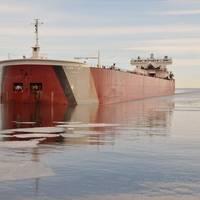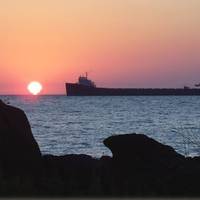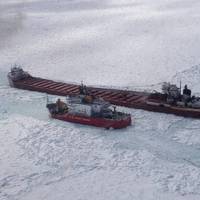Customs Demands Bigger Bonds as Tariffs Bite

Stephen Wang is counting the costs of President Donald Trump's trade war. He had to put down 12 times more cash as a guarantee to U.S. customs that he would pay the bill for tariffs on the Chinese-made pumps, valves and motors he imports.The cost of the guarantee - a U.S. customs bond - has shot up, an additional hit to importers already facing steep customs bills adding up to tens of billions of dollars for tariffs imposed by the Trump administration on incoming Chinese goods…
INSIGHTS: Lorry Wagner, Ph.D., President, LEEDCo

Dr. Lorry Wagner has served as president of the Cleveland-based Lake Erie Energy Development Corporation (LEEDCo) since May of 2010.LEEDCo is the public private partnership behind the effort to construct Icebreaker Wind, a 6 turbine 20.7 megawatt offshore wind energy demonstration project in Lake Erie, 8 miles off the shore of Cleveland. LEEDCo has received funding from the U.S. DOE under its Advanced Technology Demonstration Projects award and has partnered with Fred. Olsen Renewables of Norway. Dr.
Duluth-Superior Shipping Season Underway

The first two U.S.-flag lakers are on schedule to depart the Port of Duluth-Superior Tuesday, March 22, signaling the start of the 2016 commercial shipping season at this, the farthest inland port on the Great Lakes St. Lawrence Seaway (GLSLS) system. Shortly after 7 a.m., the Edwin H. Gott, is scheduled to move from its winter berth at the Clure Public Marine Terminal – first to fuel, then to depart mid-morning beneath Duluth’s famed Aerial Bridge en route to the CN Dock in Two Harbors to load iron ore pellets. Shortly thereafter, another ship in the Great Lakes Fleet, the Philip R.
Great Lakes Freighters Getting Underway Again
The Lake Carriers’ Association (LCA) announced that the 2016 shipping season on the Great Lakes began on March 2 when the tug/barge unit Dorothy Ann/Pathfinder loaded 4,600 tons of iron ore at Cleveland Bulk Terminal for delivery to ArcelorMittal Cleveland at the end of the navigable portion of the Cuyahoga River. That much iron ore will keep the mill in operation for about one day. The vessel could have delivered another 4,100 tons, but the Cuyahoga River is notorious for silting up over the winter, and the U.S. Army Corps of Engineers will not dredge the river again until mid-May. The next vessel to get underway will be the cement carrier G. L. Ostander/Integrity on March 7, LCA said.
Great Lakes Cargo Volumes Down in August

Foreign steel, vessel repairs and a broken lock combine to cut U.S.-flag Great Lakes float 10 percent in August, according to the Lake Carriers’ Association (LCA). Continued high levels of steel imports, coupled with three large vessels idled for repairs and a lengthy closure of the MacArthur Lock at Sault Ste. Marie, Michigan, cost U.S.-flag Great Lakes fleets more than 1.1 million tons of cargo in August, the LCA said. The fleet moved 9.9 million tons of raw materials in August, a decrease of 10.3 percent compared to the 11 million tons hauled a year ago.
US-flag Iron Ore Cargos Retreat Again in July
With the nation awash in dumped foreign steel, iron ore cargos carried by U.S.-flag Great Lakes freighters (lakers) fell again in July, according to the Lake Carriers’ Association (LCA). Loadings totaled 4.7 million tons, a decrease of 10 percent compared to a year ago. The slump comes on the heels of a 10 percent decrease in June. Total cargo movement in U.S. hulls totaled 10.9 million tons in July, a decrease of 4 percent compared to a year ago. U.S.-flag lakers’ coal float increased 6.4 percent in July, but shipments of limestone dipped by 5.6 percent. The stone trade is also feeling the impacts of unfair trade in steel, LCA said. Steel production is the primary driver behind demand for fluxstone and metallurgical stone. The failure of the MacArthur Lock at Sault Ste.
Foreign Steel Cuts Lakers’ Ore Float in June
With foreign steel now commanding nearly 32 percent of the U.S. market, it was inevitable that iron ore cargos hauled in U.S.-flag Great Lakes freighters (lakers) would take a hit, and that hit came in June, the Lake Carriers’ Association (LCA) reported. Cargos totaled 4.4 million tons, a decrease of 17 percent compared to May and 10 percent compared to a year ago. “Although not unexpected, the slowdown in iron ore is troubling,” said LCA president James H.I. Weakley. “On average it takes about 1.5 tons of iron ore to make a ton of steel, so foreign steel that is dumped into the U.S. market takes ore and other cargos off the Lakes. It is imperative that the government enforce our trade laws…
April Ice Hinders Great Lakes Ore Trade
Shipments of iron ore on the Great Lakes and St. Lawrence Seaway totaled 4.3 million tons in April, nearly 15 percent below the month’s long-term average, the Lake Carriers’ Association (LCA) reported. The heavy ice blanketing the Lakes not only slowed the vessels that were in service, it delayed many vessels from sailing. Several U.S.-flag vessel operators held back ships rather than sit in ice because the U.S. and Canadian Coast Guards do not have enough icebreakers to adequately cover the system. “April was again proof positive that we need more icebreaking resources,” said James H.I. Weakley, president of LCA, the trade association representing U.S.-flag vessel operators on the Great Lakes.
Great Lakes Ore Trade Off to a Slow Start
Shipments of iron ore on the Great Lakes totaled just 800,000 tons in March, the lowest level for the month since 2010 and nearly 60 percent below the month’s five-year average, the Lake Carriers’ Association (LCA) reported. Heavy ice and lack of icebreaking resources on both sides of the border were the culprits, according to the LCA. “The winter of 2014/2015 was again brutal,” said James H.I. Weakley, President of Lake Carriers’ Association. “The ice formations were so formidable that a number of LCA’s members chose to delay getting underway rather than risk a repeat of last spring when ice caused more than $6 million in damage to the vessels. Compounding the problem is that both U.S. and Canadian icebreakers have experienced a number of mechanical issues. The Mackinaw, the U.S.
Great Lakes Freeze Cost Economy $705m, 3,800 Jobs

The seemingly glacial ice that brought shipping on the Great Lakes to a virtual standstill last winter cost the economy more than $700 million and nearly 4,000 jobs, the Lake Carriers’ Association (LCA) reported, promting the group to to call for construction of a second heavy icebreaker to partner with the U.S. Coast Guard’s MACKINAW to keep the shipping lanes open in the harshest of conditions. According to LCA, the winter of 2013/2014 was so brutal that U.S.-flag cargo movement between December 1, 2013 and May 30, 2014, plummeted nearly 7 million tons compared the same period in 2012/2013.
Keeping up with the Jones (Act)

The continued existence of the Merchant Marine Act of 1920 carries with it substantial economic and financial benefits. Its repeal could be catastrophic. The three-legged stool commonly referred to as the Jones Act is officially known as the Merchant Marine Act of 1920. For the purposes of national defense and growth of domestic commerce, it most simply calls for the waterborne transport of cargo and/or passengers between U.S. ports to be limited to U.S. flagged vessels. Its continued existence carries with it substantial economic and financial benefits. Its repeal could be catastrophic.
Report: Tariff Cost Ports Money, Jobs
According to reports, a 20-month tariff on imported steel resulted in a loss of 9.3m tons of the metal and more than 2,000 jobs at U.S. ports, according to a new report from a maritime economics consulting firm. The study by Martin Associates of Lancaster, Pa., commissioned by the American Institute for Imported Steel and the first to document the economic impact of the tariff, found that the trade restriction kept about 424,000 tons of steel and iron from going through U.S. ports in 2002 and 2003. The metals were instead shipped to other countries. The data will be used to oppose future tariff threats and to educate policymakers, said David Phelps, president of the AIIS.
U.S.-Flag Carriage Inches Upward Again In June
U.S.-Flag shipments of dry-bulk cargo on the Great Lakes in June totaled 11.4 million net tons, a decrease of 3 percent compared to a year ago. However, the June total represents the second month in a row in which the gap between this season and last has narrowed significantly. The 2002 season began with a 20-percent decrease in April, the first full month of navigation in the dry-bulk trades, but May float was down by 9.4 percent. Another positive sign in June was the sailing of three idled lakers. Oglebay Norton Marine Services Company activated its BUCKEYE on June 8 and its COURTNEY BURTON on June 15. Both vessels are mid-sized self-unloaders. Interlake Steamship sailed its 1,000-footer JAMES R. BARKER on June 29.
ISH: Steel Import Sanctions Hurt 4Q Earnings
International Shipholding Corp., in announcing its fourth quarter results yesterday, noted that while fourth quarter results were improved from the third quarter, the period was negatively impacted by lower results in the company’s TransAtlantic LASH service, which experienced reduced cargo volume largely because of U.S. sanctions on foreign steel imports. For the three months ended December 31, 2002, recorded revenue was $58.3 million versus $65.9 million during the same period in the previous year. For the year ended Dec. 31, the company recorded revenues of $217.7 million versus $289.9 million during the previous year. This is countered with reduced voyage expenses (Three months ended $45.9 million vs. $53.5 million in 2001; 12 months ended $177.8 million vs.
St. Lawrence Seaway Closed Until Spring
The St. Lawrence Seaway is officially closed to navigation until spring. The last vessel to pass through the Seaway was the chemical tanker Petrolia Desgagnes, which made its way through the St. Lambert lock near Montreal, Quebec, on Dec. 25. The seaway, which was open to navigation for 270 days starting March 31, maintained its maximum draft of 26 ft., 3 in. despite the low water levels in the Great Lakes. The Seaway's toll revenue and cargo tonnage was down this year because of reduced demand for inbound foreign steel, according to Seaway officials. Estimated combined cargo moved through the Welland Canal, between Lake Ontario and Lake Erie and the Montreal/Lake Ontario sections, totaled 47.56 million tons, down seven percent from a year ago.
St. Lawrence Seaway Closed Until Spring
The St. Lawrence Seaway is officially closed to navigation until spring. The last vessel to pass through the Seaway was the chemical tanker Petrolia Desgagnes, which made its way through the St. Lambert lock near Montreal, Quebec, on Dec. 25. The seaway, which was open to navigation for 270 days starting March 31, maintained its maximum draft of 26 ft., 3 in. despite the low water levels in the Great Lakes. The Seaway's toll revenue and cargo tonnage was down this year because of reduced demand for inbound foreign steel, according to Seaway officials. Estimated combined cargo moved through the Welland Canal, between Lake Ontario and Lake Erie and the Montreal/Lake Ontario sections, totaled 47.56 million tons, down seven percent from a year ago.












